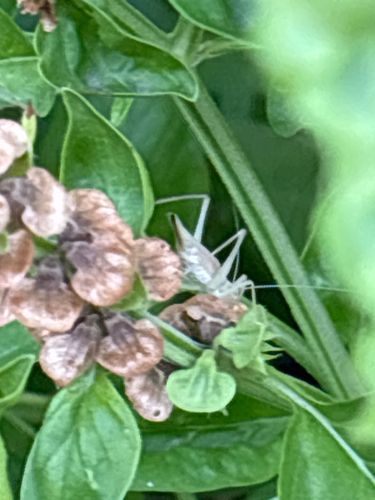Cricket (likely a tree cricket or a young field cricket)
Scientific Name: Gryllidae (family), possibly Oecanthinae (subfamily for tree crickets) or Gryllinae (subfamily for field crickets)
Order & Family: Order: Orthoptera, Family: Gryllidae
Size: Generally 0.5 to 1.5 inches (1.2 to 4 cm) depending on species and maturity level (the one in the image appears to be a nymph or smaller species).

Natural Habitat
Found in various habitats, including grassy areas, fields, gardens, trees, and shrubs. Tree crickets prefer foliage and shrubs, while field crickets are often found on the ground or in taller grasses.
Diet & Feeding
Omnivorous. They typically feed on a variety of plant matter (leaves, flowers, fruits, seeds), fungi, and sometimes small insects or decaying organic matter. Tree crickets are known to consume aphids and other small insects.
Behavior Patterns
Nocturnal with some exceptions; known for their characteristic chirping sounds produced by males rubbing their wings together to attract mates. They are good jumpers and can be quite agile. Nymphs (like the one pictured, if it's a juvenile) undergo several molts before reaching adulthood.
Risks & Benefits
Generally harmless to humans. Can be considered agricultural pests if populations are very high, as they may feed on crops. However, they also serve as a food source for other animals (birds, small mammals, reptiles) and can help with decomposition of organic matter. Tree crickets can also be beneficial by preying on some pest insects like aphids.
Identified on: 9/20/2025